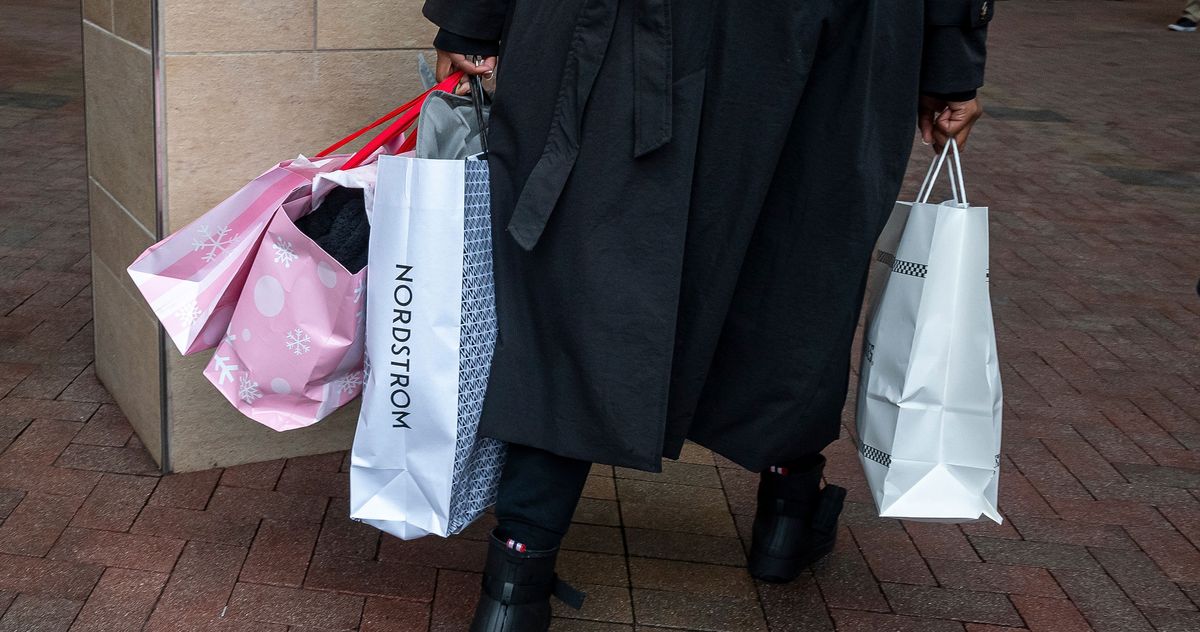Photo: David Paul Morris/Bloomberg via Getty Images
Last week, President Donald Trump announced extensive tariffs (a.k.a. taxes) on imported goods, including a 10 percent general tariff on all imports and tailor-made rates on certain trade partners like China, with a 34 percent tariff and subsequent threat of an additional 50 percent tariff, and a 10 percent tariff on an uninhabited island off Antarctica. Genius!
Since the announcement, global markets have essentially gone into free fall. According to Business of Fashion, Lululemon shares dropped over 10 percent, while shares of Nike and Ralph Lauren fell 7 percent. The future feels increasingly unknown, including just how much these tariffs are going to affect how we shop here in the U.S.
Over 97 percent of apparel and shoes in America are manufactured overseas in countries like Vietnam, which is a major supplier to brands like Nike and is now dealing with a 46 percent tariff. Even companies that boast their products are American-made may have supply chains that include manufacturing abroad. There’s a common misconception that the country goods are shipped from is responsible for fronting the tariff on them, but actually, the importer is. It’s still unclear how companies will handle these new taxes. Some Asian manufacturing hubs like Cambodia and India seem willing to make concessions in Trump’s tariff wars, but in the meantime, everyday people like you and me can probably expect our clothes to get more expensive. While the price a company is taxed at will be on the declared value of the product, the companies importing these products will be paying these increased costs and left to figure out how much of that tariff to pass on to the consumer to make up the difference, likely by charging a higher retail price that will come out of the customer’s wallet or by opting for cheaper-quality goods. Here’s what we know so far.
There’s a chance all of them could get more expensive. Like we said, 97 percent of American clothing and shoes are made abroad. It’s unclear exactly how companies are planning on making up for their increased cost of manufacturing, but as Columbia Sportswear CEO Timothy Boyle told the Washington Post after Trump’s election, “We’re set to raise prices … It’s going to be very, very difficult to keep products affordable for Americans.”
According to Marie Claire and a study by the National Retail Federation, these tariffs could decrease Americans’ spending power by up to $78 billion each year going forward. “Costs retailers need to absorb will be too high for them to pay alone,” Halie LeSavage writes. “So prices we all see at the store will rise.” As fashion writer Amy Odell wrote back in November, “Buy now. If you were planning on a fashion splurge, shop now. If you’re planning to stock up on socks and T-shirts, shop now — now is the time. Because I think that we’re only going to see prices increase if these things move forward.” Don’t overconsume, but I’m personally going to take that advice.
Likely no. As of March of this year, there are only about 84,000 people working in the garment industry in the U.S., according to the Bureau of Labor Statistics. Industry experts who spoke with Fast Company noted that reviving domestic garment manufacturing, if feasible, “would be hugely expensive and take years.” The outlet also notes that, according to comments from the Footwear Distributors & Retailers of America, goods needed to make certain apparel, like shoes, are not manufactured and do not exist in the U.S. “Shoe companies would need to find or set up factories to make cotton laces, eyelets, textile uppers, and other components to make finished footwear in the U.S. on a large scale,” the group wrote. “These materials simply do not exist here, and many of these materials have never existed in the U.S.”
Back in March, a spokesperson from Ssense told Complex, “most of our customers will experience little to no impact on their orders. The incremental tariffs apply to goods originating from Canada, Mexico, and China. However, the majority of our products are sourced from other regions.” Since then, though, Trump has announced sweeping tariffs internationally, including a general 10 percent tax on all imports. Ssense didn’t immediately respond to a request for comment about how the latest tariffs may impact its customers.
Alongside the increased tariffs on China, where Shein and Temu are located and ship from, Trump’s executive order will also eliminate the “de minimis provision” for goods from China and Hong Kong on May 2. The provision served as a tax exemption on imports of $800 or less, which helped these drop-shipping companies thrive. Without it, according to the White House, “postal items containing goods that are sent through the international postal network that are valued at or under $800 and that would otherwise qualify for the de minimis exemption are subject to a duty rate of either 30 percent of their value or $25 per item (increasing to $50 per item after June 1, 2025).” Basically, shipping will get more expensive for fast fashion companies like Shein and Temu, and consumers can expect to be burdened with at least some of the cost.
These tariffs don’t look good for Amazon. The company is largely reliant on Chinese manufacturing and Chinese third-party sellers on the platform. John Herrman, New York’s tech columnist, writes, “Without much ‘headroom’ to absorb these tariffs, Amazon prices could go up across the board.” But lest we forget, Amazon’s executive chairman, Jeff Bezos, has been canoodling with Trump since Election Day. According to Herrman, with these taxes hitting Chinese-owned companies that only ship from China, like Shein and Temu, there’s a good chance prices at Amazon will stay relatively cheap. “Amazon’s retail business is diversified in ways that could mitigate tariffs,” he writes. “So everyone’s prices will be higher, but Amazon’s will be relatively low, and its lower-end major competitors will have been neutralized, leading customers back to Amazon, where shipping is faster and they probably already subscribe to Prime anyway.”
Even though LVMH, owner of brands like Dior, Louis Vuitton, Fendi, Givenchy, and Tiffany and Co., opened up a factory in Texas, Business of Fashion still anticipates the company will take a hit to the tune of an 8 percent decrease in profit. The outlet also projects Kering, owner of Balenciaga and Gucci, will lose about 14 percent of its profit margin, and that Burberry could fumble a whopping 44 percent in profit.
Nearly all brands will likely be affected, even the ones that tout being American-made. As Dieux founder Charlotte Palermino explains, her products are made in the U.S. But even when they hired an American-based manufacturer to create the tubes that her skin-care products come in, part of that manufacturer’s supply chain was in China. Most large businesses have supply chains where at least part of production takes place overseas. “Manufacturing will take decades to come back,” Palermino says. “The interim will be devastating for business and the average person.”


